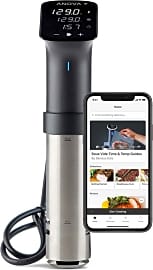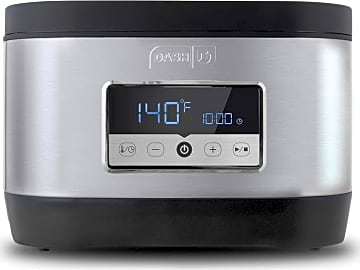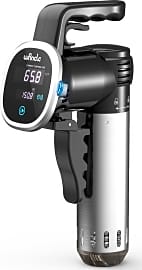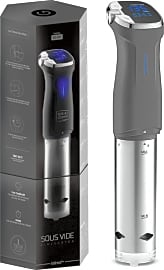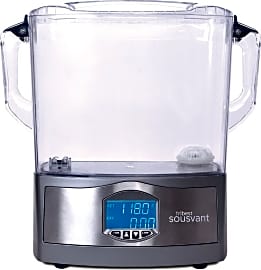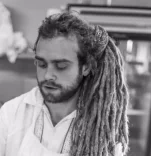The 9 Best Sous Vide Cookers

This wiki has been updated 39 times since it was first published in September of 2015. Experience meats you've been eating for decades as if it was the first time with one of these sous vide cookers. Just seal your food in an airtight plastic bag, immerse it in water, and you'll wind up with succulent, moist, and evenly-cooked meals every time. They're available in a range of styles, and some even feature wireless connectivity, so they can be monitored or controlled from anywhere. When users buy our independently chosen editorial selections, we may earn commissions to help fund the Wiki.
Editor's Notes
July 15, 2021:
While the Instant Pot remains one of the most popular crock pots and multi-cookers on the market, the company has discontinued its sous vide circulator so we've removed it from the list. The only other difference in this round is the Anova Culinary Nano vaulting into the #1 spot. It's not ideal for commercial use but does perform nearly as well as its more expensive relative, the Anova Culinary Precision Pro. The Breville Joule is also especially notable, as it heats up water even faster than the Nano. It does have two potential drawbacks, though; it's very expensive and it doesn't have onboard controls, but works only in conjunction with a smartphone.
July 21, 2020:
Sous vide cookers may once have been something only found in commercial kitchens. But these days, as they become increasingly more affordable and compact, there is no reason why the average home cook can't use one to prepare restaurant-quality meals. Thanks to their precision control, they make it nearly impossible to overcook a piece of meat and produce some of the most tender cuts you've ever had.
When it comes to modern features, the Anova Culinary Precision Pro, Breville Joule, and Anova Culinary Nano immediately stand out. The first two are both Wi-Fi ready, so you can connect them to your home network and control or monitor their status from anywhere using your smartphone. The Joule can even integrate with Amazon's Alexa, however it doesn't have any physical controls on the cooker itself. The Anova Culinary Nano can also be controlled via a smartphone, but it only offers Bluetooth, so you'll need to be within 30 feet of the unit to do so.
Those looking for something powerful and durable enough for commercial use should turn to the Anova Culinary Precision Pro or PolyScience Chef Series SVC-AC1B. The former circulates 12 liters of water per minute and can run continuously for weeks on end, so it shouldn't burn out no matter how busy your kitchen is. The latter is ETL commercial and sanitation approved, has a high-grade stainless steel heating coil and pump, and can be re-calibrated as needed.
While we think most homes will be best served with a wand model due to their compact size and versatility to work with a wide variety of containers, we do realize some people may find them complicated and would prefer an all-in-one unit like the Dash Chef Series 8.5-quart and Tribest Sousvant SV-101. Both feature integrated water bins and offer simple controls akin to what you might find on a crockpot.
Whichever model you choose, for the best results you should seal your meat in an airtight bag using a vacuum sealer before submerging it in the water bath.
May 01, 2019:
If you want a lot of useful features without spending an arm and a leg, the Anova Culinary Nano is the way to go. It can be controlled from your smartphone using the company's app, which is easy to use and includes thousands of recipes and cooking guides. The ChefSteps Joule, our previous top pick, has both wifi and Bluetooth capabilities, so it can be controlled from much greater distances, but there is no control panel on the device itself, so be aware that it won't work without your phone. It heats water very quickly, and its clever magnetic base allows it to cook with less water since it sticks to the bottom of the pot. The Instant Pot Accu Slim is one of the best low-cost options on the market, and it's also one of the simplest to use. It works with 6- and 8-quart Instant Pots, but can be used with regular containers, too. The Sous Vide Supreme and Tribest Sousvant are self-contained machines that eliminate the need for a separate pot or container, which makes for an easy setup, but also limits the size of the meals you can cook.
Special Honors
FusionChef Diamond XL One of the most advanced models on the market, the FusionChef Diamond XL boasts fifteen customizable pre-sets and three separate timers, making it easy to cook multiple cuts of meat at once. Due to its cost, size, and industrial look, it is best suited to commercial kitchens that prepare a high volume of food. fusionchef.us
Invention Of Sous Vide Cooking
Much later in the 1960s, American and French engineers re-discovered the concept and created industrial sous vide machines for food preservation.
The theory of sous vide was first proposed by physicist and inventor, Sir Benjamin Thompson in 1799. He described a system that used hot air to precisely control temperature over a long period of time to cook meat. Unfortunately for the culinary enthusiasts of the 19th century, he never created a device to accomplish this feat and the theory was forgotten for the next 150 years.
Much later in the 1960s, American and French engineers re-discovered the concept and created industrial sous vide machines for food preservation. This method of food preparation is what inspired French Chef Georges Pralus to look at sous vide as a way of cooking food. In 1974, while working at Troisgros, a three-Michelin star restaurant, he noticed that when he cooked a piece of foie gras, it shrunk by 40 to 50% and would lose its shape. He began to experiment with vacuum-packing it and cooking it in warm water baths in an attempt to preserve its size and shape. It worked and not only saved the restaurant a small fortune on foie gras costs, but also gave rise to a unique culinary technique.
He wasn't alone in his quest for a better way to cook meats. Around roughly the same time, Bruno Goussault was using the sous vide preservation technique in his home to increase the shelf life of frozen meat. He is credited with much of the understanding of the science behind the sous vide method. He researched the effect of temperature on a variety of foods in sous vide baths and is known to have trained many of the best chefs in the technique.
Both men claim to have invented sous vide, but are probably both equally deserving of the credit. Without one or the other, sous vide would not be in the repertoire of chefs today. In 1980 they collaborated to bring the process under French food safety standards so it could be used in professional restaurants.
Benefits Of Sous Vide Cooking
Sous vide allows anyone to achieve 100% consistent results that would be nearly impossible with traditional cooking techniques. The sous vide method is the only way to get a perfectly even cook on a piece of meat. In order to reach the ideal core temperature with a traditional cooking method, the outer edges must be subjected to a high temperature long enough for the heat to reach the core and properly cook it. This results in meat that has slightly overcooked edges, with a perfectly cooked interior. With a sous vide machine, every layer of meat from the edge to the center will be cooked to the exact same temperature.
Instead of having to constantly watch the food in a pan or check its temperature in the oven, you can set the sous vide machine to a specific temperature and walk away.
Sous vide is also a healthier way to cook foods for two reasons: higher vitamin levels and less fatty oils. When cooking meats or vegetables on a pan or in the oven, one must coat them with enough oil to prevent them from sticking to the pan. With sous vide, there is no need to add any unhealthy oils to your food. It also allows you to preserve more of the vitamins naturally found in your food. High heat is known to break down vitamins, but sous vide doesn't expose your food to the extreme temperatures experienced in oven roasting and pan frying.
It can also help you save time and money. Instead of having to constantly watch the food in a pan or check its temperature in the oven, you can set the sous vide machine to a specific temperature and walk away. There is no chance of accidentally overcooking or burning your food. The sous vide technique also allows you to purchase cheaper cuts of meat and make them just as tender as the more expensive cuts you normally work with.
How To Sous Vide Properly
Sous vide is a simple cooking method that anyone can master after a few attempts. The first step is to start your warm water bath. This will allow it heat up while you prepare your food. Follow your particular device's instruction manual, which should give a detailed step-by-step guide on setting it up, turning it on, and adjusting the temperature. If you are unsure of the ideal temperature setting, consult a meat and poultry temperature guide.
Follow your particular device's instruction manual, which should give a detailed step-by-step guide on setting it up, turning it on, and adjusting the temperature.
The next step is to season your food and seal it in a bag. When first starting out, consider using less seasoning than you normally use when pan frying or oven roasting. Unlike these methods which drain a food's natural juices and burns them up, sous vide keeps these juices locked in allowing the food to retain its natural flavor. Seasoning your food can be as simple as adding some salt and pepper, or you can get more creative and add some herbs and aromatic spices. Once seasoned, use a vacuum sealer to suck out the air and seal the sous vide bag.
Your food is seasoned and sealed, and your sous vide machine has reached the ideal temperature; now it is time to start cooking. Slowly drop the sealed bag into the warm water bath, making sure it fully submerges in the water, then set the timer and wait. After your food has finished cooking remove it from the water, cut the bag and remove the contents. If you are cooking meat, fish, or poultry, it is advisable to sear it in a very hot pan or with a culinary torch to caramelize the exterior before serving.



